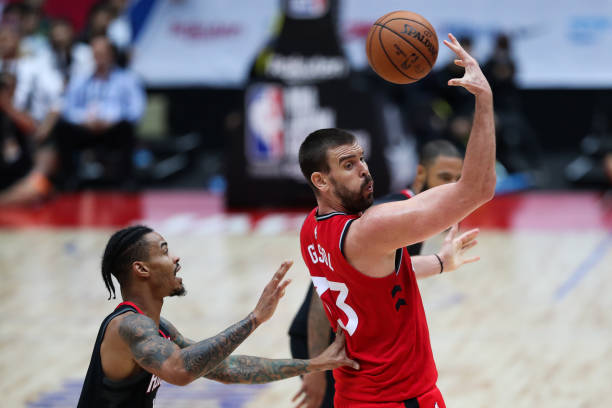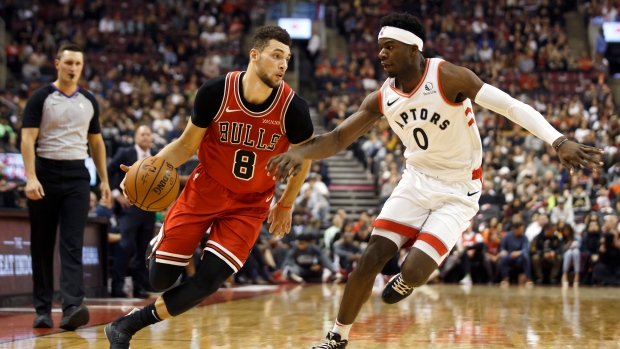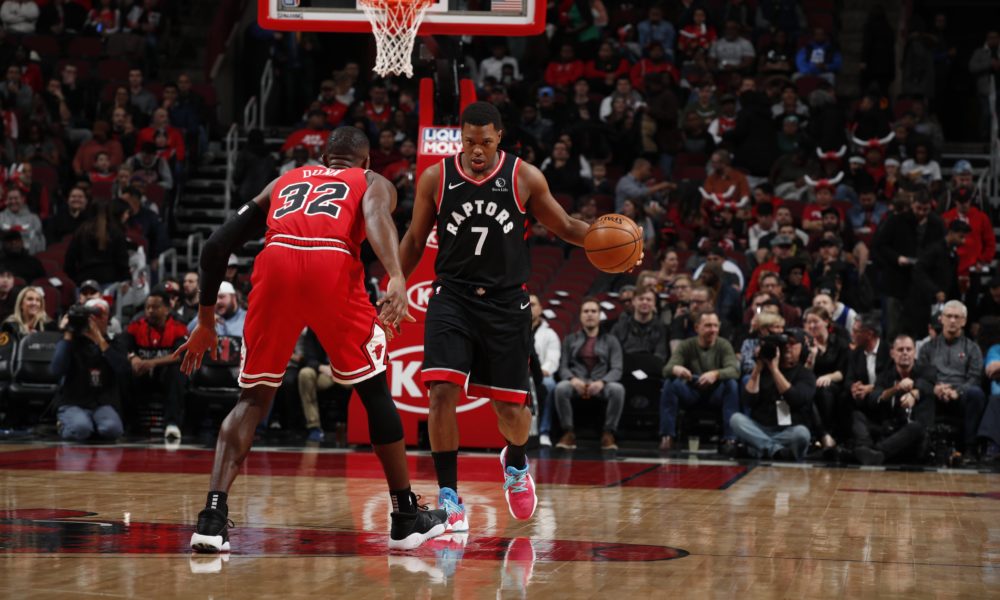Last week was a tough one for the Raptors, who lost three straight for the first time since November 2018, falling to 15-7 on the season. To put it in context, though, their losses came against three of the best teams in the league: the Houston Rockets, Miami Heat, and the Philadelphia 76ers. Also, the Raptors were trying to reintroduce Kyle Lowry and Serge Ibaka into the rotation, and both of them showed rust in their first games back.
Give credit to the likes of James Harden, Jimmy Butler, and Tobias Harris who made the Raptors pay for aggressive defensive schemes. A lot has to go wrong for this Raptors team to lose, and only a few things need to go right for them to remain competitive (which we saw against the 76ers on Sunday night). Still, they have a small margin for error against the leagues’ best teams.
This upcoming week should be easier for the Raptors, but they still have a very difficult December to get through.
Here is a breakdown of their upcoming schedule:
- Monday, December 9th at 8:00pm: Toronto Raptors @ Chicago Bulls (8-16)
- Wednesday, December 11th at 7:00pm: Los Angeles Clippers (17-7) @ Toronto Raptors
- Saturday, December 13th at 7:30pm: Brooklyn Nets (13-10) @ Toronto Raptors
- Combined winning percentage: 53.5%
Let’s look ahead to the five most interesting storylines for the upcoming week:
1. Defensive schemes
Head coach Nick Nurse has been really aggressive with his game plans all season, particularly on the defensive end. Nurse opts to send regular double teams at superstars, including this past week against Harden and Butler, and both the Rockets and Heat made the Raptors pay by having their stars make the right decisions to pass out of the double-teams and their role-players knocking down open shots.
Even against the Sixers, who are without a perimeter superstar, the Raptors sent double teams at the likes of Ben Simmons, Tobias Harris, and Joel Embiid when they had the ball in the post, and oftentimes they passed out for open threes.
In the last three games, opponents made 51 three-pointers on 125 attempts, good for 41.1 percent. Due to the aggressive defense and double teams, the Raptors are allowing a ton of corner threes (they gave up 23 against the Rockets) and open above-the-arc threes, which are shots players will regularly hit.
The good part about these defensive schemes is that the players are buying in and that shows the trust they have in their coaching staff. Another positive is that experimentation is good, especially this early in the regular season, because it gives the team experience playing a style they will likely need to play in the playoffs against teams with perimeter superstars like the Milwaukee Bucks and Miami Heat. Also, the Raptors have been effective in minimizing superstars all season.
“At the end of the day our coach is very innovative, and he tries things, and he’s creative, and we’re a team that buys into what he decides to do,” Kyle Lowry said. “I think everything is worth a shot, worth a try.”
However, after an 0-3 week, the Raptors have dropped from second to fifth in the Eastern Conference standings, and at least part of that has to do with the defensive schemes not working as intended.
Sometimes role players are going to light you up from deep if you give them too much room to shoot, and other times superstars just don’t have it going every night. The game plan should be more adaptable depending on who is playing well that night, so before role players like P.J. Tucker and Ben McLemore hit a combined 13 threes, you adjust.
I understand that it is the Raptors offense struggling as of late, but with such a small margin for error against good teams, you can’t allow that many good looks on defense.
It will be interesting to see how Nurse adapts his game plan to his upcoming opponents, because with Kyrie Irving still injured, only the Clippers have a superstar, and they have two. It will be hard to double Leonard or Paul George regularly with the other waiting for the ball, and it will be unnecessary to double the likes of Zach Lavine or Spencer Dinwiddle.
Still, I’m looking forward to seeing what Nurse has up his sleeve because if there’s one thing that is for certain, its that he does have something up his sleeve. I, for one, appreciate that.
2. Who runs the offense?
This one largely depends on when VanVleet returns from a right knee contusion he suffered against the Rockets on Thursday, which bothered him again on Sunday against the Sixers, forcing him to leave the game and not return.
However, since the injury doesn’t sound too serious, VanVleet will likely be back before the end of the week, rendering this storyline worthwhile.
I think one argument that some fans have made which is worth repeating has to do with the offense looking better when Lowry and Ibaka were injured. The offense did seem to flow better and generate better shots when Fred VanVleet and Marc Gasol were running it. Siakam, for his part, is going to get his shots and opportunities regardless of who he is sharing the floor with.
This is not to say “trade Lowry!” or “Lowry to the bench!” because those are outrageous claims, in my opinion. However, it might be worth running a little more of the offense through VanVleet and Gasol, with Lowry acting as a spot-up option or secondary facilitator in the starting lineup, instead of being the primary guy. He will still get his time to act as the primary (and only) facilitator in the Lowry-plus-bench lineups.
In the 11 games Lowry missed due to injury, VanVleet averaged 7.5 assists and Gasol averaged 7.0. Even compared to their season averages of 7.0 and 3.5, respectively, those are incredibly impressive marks, and my eye tests agrees that the offense looked really good and natural with those two running it. When Lowry is the primary facilitator, it means Gasol has to take a major step back, but his creation from the top of the arc or elbow is so important to the identity of this team, which is that they can play so many different styles. The Raptors become more predictable when Lowry and VanVleet, two perimeter players, are the two primary facilitators.
Lowry already plays off the ball a lot for a starting point guard, but it might be worth it to try him off the ball even more considering he is one of the Raptors best three-point shooters (shooting 39.1 percent this season), can attack closeouts, and will always make the extra pass when necessary.
A more equal-opportunity offense with VanVleet, Gasol, and Lowry running the offense together could help improve an offense that is struggling. With all the experimentation being done on the defensive end, it may be time to carry it over to the offense.
3. Siakam staying in the MVP conversation
Pascal Siakam is averaging career highs in minutes (36.8), points (24.6), rebounds (8.5), and assists (3.7).
He is performing better than anyone could have expected, on his way to his first All-Star appearance and likely an All-NBA team. He has also been in the MVP conversation to start the season, regularly mentioned after Giannis Antetekounpo, Harden, LeBron James, and Luke Doncic.
When asked, “Who of the dark horse candidates (+2500 odds) has the best chance of winning it?” four-out-of five ESPN experts picked Siakam. Kevin Pelton said:
“Siakam. If the Raptors can somehow win the East, Siakam will get plenty of MVP consideration, even if it’s unlikely he actually wins the award”.
That Siakam is even in the MVP conversation is mindblowing, especially considering he averaged 7.3 points two seasons ago, but will he stay in it for the remainder of the season?
Siakam’s scoring has fallen off lately, as he is averaging 20 points in his last five games. Part of that has to do with defenses adjusting to Siakam after he set fire to the league to start off the season. Opponents are game-planning for him like the Raptors gameplan for superstars, and he is having trouble adjusting to the weight a No. 1 option must carry.
A lot of it has to do with Siakam needing to be more aggressive. He regularly fails to take advantage of the mismatches created for him, passing up on opportunities to post up smaller players or take slower big men off the dribble.
“Not making shots, not being aggressive enough. I’m going to keep saying that. I have to shoot 30 shots before feeling like (I can back off). That’s the type of player I have to be,” Siakam said about what he can do better. “It’s an adjustment period for me, too, understanding that. I’m not saying I’m the best player on the team, I’m saying I have to make plays and I have to keep attacking. Sometimes, just the type of person I am, sometimes you just want to ‘Okay, I’m not playing well, let me try to do other things.’ But at the same time you have to do other things but understand you are that person and you have make those plays. There is no one to look at to make those plays and you have to take charge. It’s me and I have to continue to get better and make sure I don’t let my offence or anything like that dictate the way I play. So I have to be better like that and find other ways to impact the game, and also understand that I am that person.”
Siakam clearly understands what he can do better, and he will adjust as the season goes on. He is an elite post-up player, ranking fourth in the league with 1.00 points per possession on 81 possessions. He is also elite in isolation, scoring 0.89 points per possession on 4.5 isolations possessions per game (fifth-most in the league).
Given how good Siakam is, it can sometimes be confounding when he is absent on the offensive end down the stretch like he was against the Heat. In order to stay in the MVP conversation, he will need to assert himself each and every game. And he knows it.
4. Ibaka vs. Boucher
After averaging 17.3 minutes per game with 9.1 points, 6.6 rebounds (3.2 offensive), 0.9 blocks and just 0.6 turnovers on 49.3 percent shooting in the ten games Ibaka missed due to injury, Chris Boucher is averaging just 3.0 minutes per game in the four games since Ibaka’s return.
Ibaka, meanwhile, has really struggled since returning from injury, averaging 12.0 points, 6.25 rebounds (2.5 offensive), 0.25 blocks, and 2.5 turnovers on 39.8 percent from the field while playing 21.8 minutes per game. Of course, a lot of that can be chalked up to rust after missing ten games due to a severe ankle sprain, and it’s worth noting Ibaka started the season in incredible shape, playing the best basketball he has played in years.
But asking Ibaka to return to the form he started the season in might be a tall order considering how inconsistent he has been in recent seasons. Last season was a good reminder that Ibaka is best when he is playing no more than twenty minutes per game, mostly against backup centers.
Fortunately, the Raptors have a lot of big-men depth, and Boucher can do a lot of the things Ibaka is supposed to do well like shoot threes, block shots, and rebound.
Boucher’s ability to space the floor — he shot 32.0 percent on 2.5 three-point attempts per game in that stretch without Ibaka — allows him to play in almost lineup, whether it’s with a traditional big man like Gasol or Ibaka or with Hollis-Jefferson.
He is also an elite rebounder, averaging 12.7 rebounds (6.7 offensive) per 36 minutes this season, which is an area the Raptors have struggled with all season, ranking 24th in the league in rebounding percentage at 48.8%.
Unless Ibaka returns to form quickly, it might be worth giving Boucher another look in a Raptors rotation that desperately lacks rebounding, and at times lacks three-point shooting and rim-protection. At this point, we know who Ibaka is and what he brings to the table. Can we say the same about Boucher?
5. Minutes running high
The Raptors have three of the top six minutes per game leaders in the NBA. Lowry ranks second at 37.3, Siakam is fifth at 36.8, and VanVleet is sixth at 36.6.
These things are highly variable this early in the season. In fact, heading into Sunday’s contest against the Sixers, VanVleet was leading the league in minutes.
Credit Lowry, Siakam, and VanVleet, who have all been exceptional this year, giving Nurse little choice but to play them a lot. They are all major contributors on both ends of the floor who play hard and make smart decisions, which the coaching staff rewards with minutes.
And yet, that is a lot of minutes for three of your star players to average throughout a season when we know the Eastern Conference playoffs are going to be a bloodbath.
Kawhi Leonard’s load management last season was unique to him but it sent the general message that rest is good for players whose goal is to win a championship, especially for a team coming off a championship run.
Nurse might want to consider lightening the load for his three stars, particularly for Lowry who is 33 years old with 13 years of NBA experience under his belt with a history of injuries.
The bench players proved their value in the time Lowry and Ibaka were out with injuries and have since seen their roles reduced significantly. Maybe it’s time to give them more of an opportunity?



